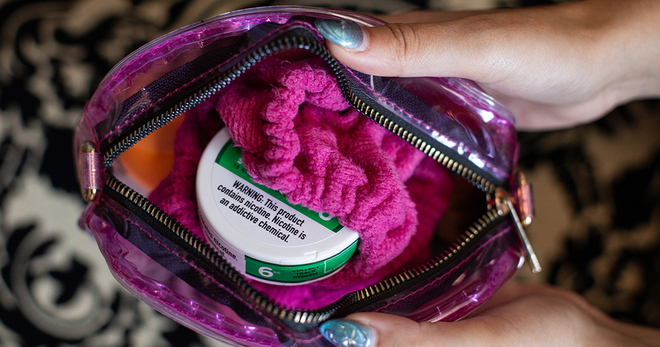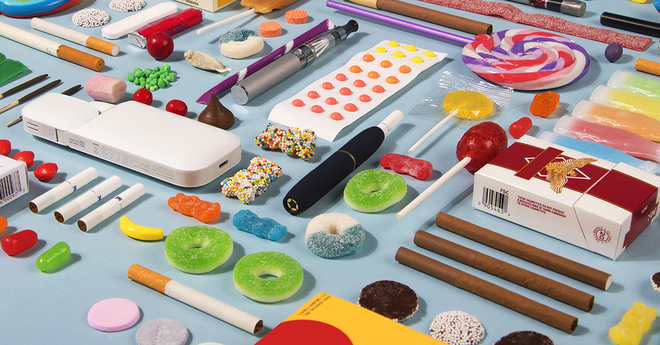Behind the explosive growth of JUUL
JUUL use rose exponentially in 2018 among young people — a majority of those who ever used JUUL or an e-cigarette report that they were younger than 18 years old when they first tried it — and its popularity with friends and the availability of flavors are top reasons for using it, according to Truth Initiative® surveys.
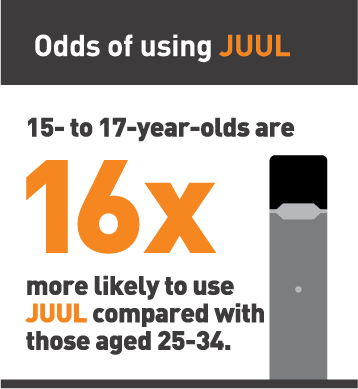
Over the past year, those surveys found that 56 percent of youth and young adults who ever used JUUL or an e-cigarette reported that they were younger than 18 when they first tried the device and nearly half — 47 percent — said that they tried it because their friends used it. The assortment of fruity and sweet flavors, which are proven to attract young people, was the second most popular reason for use, at 29 percent. The surveys also report escalating rates of youth and young adult use alongside growing sales that have tripled JUUL’s e-cigarette market share in just over a year, from 24 to 75 percent.
The survey results contribute to a growing collection of evidence that JUUL’s popularity with young people is driving its unprecedented growth. For example, a recent Truth Initiative analysis published in Tobacco Control found that teens between 15 and 17 years old have 16 times greater odds of using JUUL than 25- to 34-year-olds, with nearly 10 percent of them having tried JUUL and more than 6 percent reporting current use. Data from the National Youth Tobacco Survey show current e-cigarette use among high schoolers reached more than 20 percent in 2018 — which represents a 78 percent increase in one year.
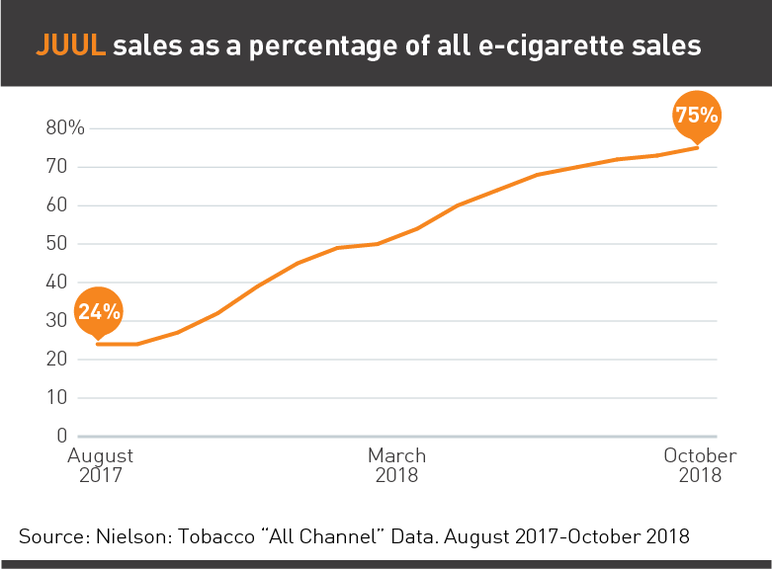
Rapid Increase in Young People Trying JUUL
Truth Initiative researchers collected data about JUUL use starting in July 2017 from a weekly survey conducted among 140 to 240 youth and young adults ages 15 to 24. The surveys used online samples and were designed to monitor trends over time and supplement nationally representative data. While not nationally representative measures of use rates, the surveys enable quick access to emerging trends.
The number of young adults between 18 and 21 years old who tried JUUL increased more than 400% from July 2017 to October 2018
Over the 15 months of the survey period from July 2017 to October 2018, which included a total of 14,479 15- to 24-year-olds sampled, there was a more than fivefold increase in youth and young adults reporting that they tried JUUL. A separate survey conducted in late July and early September 2018 found not only that many young people have used the product, but that they started at an early age. The majority of those who ever used a JUUL or e-cigarette — 56 percent — were younger than 18 when they first tried it.
Over roughly one year, the number of young adults between 18 and 21 years old who tried JUUL increased more than 400 percent from July 2017 to October 2018. Among younger users aged 15 to 17 years old, the numbers were even more stark: more than eight times as many 15- to 17-year-olds had tried JUUL in October 2018 than in August 2017.
The number of teens between 15 and 17 years old who tried JUUL also rose significantly in September, which may be associated with teens’ return to school.
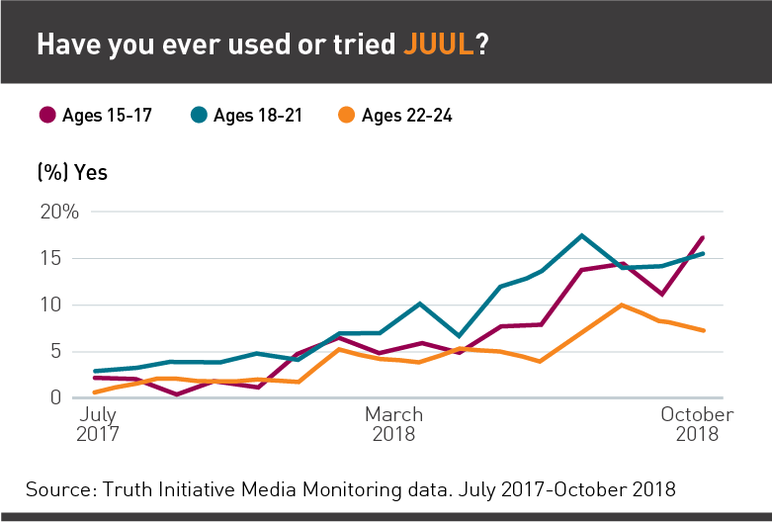
Why Young People Are Using JUUL
The surveys also revealed reasons that young people use JUUL. The top reasons for using JUUL or e-cigarettes relate to its popularity with other young people, the variety of flavors, its perception as less harmful than other products and its ability to deliver a “buzz,” according to the more than 600 youth and young adults surveyed during summer 2018 who reported ever using JUUL or e-cigarettes.
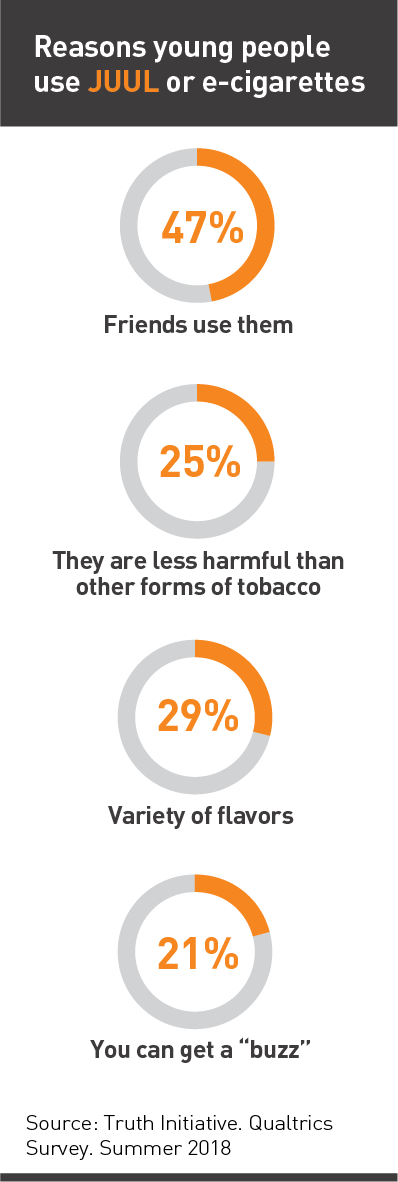
Nearly half — 47 percent — reported using JUUL or e-cigarettes because friends use it and 29 percent attributed use to the variety of flavors, including mango, fruit medley and mint. This finding is consistent with past research on flavored e-cigarettes and their appeal to youth. A study that included middle and high school students found that 43 percent of youth who ever used e-cigarettes tried them because of appealing flavors.
A quarter of young people surveyed who ever used JUUL or e-cigarettes cited the perception that it is less harmful than other forms of tobacco, and slightly less — 21 percent — said they use JUUL because it gives them a “buzz.” Despite many using JUUL to feel the effects of nicotine, it is uncertain whether young people are aware of the nicotine content of the product. In Truth Initiative research published in Tobacco Control in spring 2017, 63 percent of 15- to 24-year-olds surveyed were unaware that JUUL products always contain nicotine.
Why JUUL Matters
JUUL’s compact design that resembles a USB flash drive and availability in sweet, fruity flavors contribute to its popularity among teens. The device has become so common among youth and young adults that they have termed the practice of using it as “JUULing.” Despite the company’s claim that it only markets its products to adult smokers, there are many examples of company-sponsored and organic social media promotion of the product — calling into question JUUL’s statements that the product’s youth user base is purely accidental.

JUUL also has one of the highest levels of nicotine among e-cigarettes on the market. Before the introduction of JUUL, the most popular e-cigarette products contained nicotine strengths of between roughly 1 percent and 2.4 percent. When JUUL debuted, its pods contained 5 percent nicotine strength. Furthermore, the makers of JUUL claim that their nicotine salt formulation increases the rate and amount of nicotine delivered into the blood, compared with other formulations.
Nicotine is harmful to developing brains: younger users are more likely to become addicted, have more difficulty quitting and may be at higher risk for addiction to other substances in the future. Young adults who use e-cigarettes and who were not prior smokers and were at low risk to become future smokers have been found to be more than four times more likely to begin smoking tobacco cigarettes within 18 months compared with their peers who do not use e-cigarettes.
It is truly concerning, then, not only how many young people have tried JUUL, but also how frequent regular users reach for the product. According to the recent Truth Initiative analysis published in Tobacco Control, more than half of 15- to 17-year-old current JUUL users reported using it on three or more days in the past month and over one-quarter reported using it on 10 or more days. The National Youth Tobacco Survey found that the number of high school students using e-cigarettes at least 20 of the last 30 days rose from 20 percent to 27.7 percent from 2017 to 2018.

Action Needed
The predominance of JUUL in the marketplace, coupled with survey data from youth and young adults, reveal a troubling truth: the JUUL phenomenon is a large and growing trend among young people. Products like JUUL are addicting a new generation of young people and putting them at risk for even more dangerous combustible tobacco use, which risks reversing decades of progress in tobacco control.
Truth Initiative has long supported measures that would make tobacco products, including e-cigarettes, less appealing to youth, and ensure that youth do not have easy access to the products. While we are encouraged by recent enforcement actions from the Food and Drug Administration regarding the marketing of e-cigarettes to youth, we hope that the FDA will take swift regulatory action to protect youth from these products. Those measures include:
- Fully reviewing e-cigarette products to ensure that they benefit public health before allowing them on the market
- Removing flavors from e-cigarettes, unless a manufacturer can show that a flavor contributes to completely switching from combustible products to e-cigarettes and that it does not appeal to youth
- Prohibiting internet and non-face-to-face sales of e-cigarettes
These data also underscore the need for further FDA regulatory action to restrict the marketing and promotional efforts of e-cigarettes to younger audiences and establish mechanisms to reduce the sale of JUUL to minors. While we have been encouraged by recent FDA pronouncements recognizing this imperative, we also encourage quick action. The FDA has a lot of catching up to do, and, as the JUUL experience has starkly shown, the best time to act is before a product becomes widely used in middle and high schools across the country — not after.
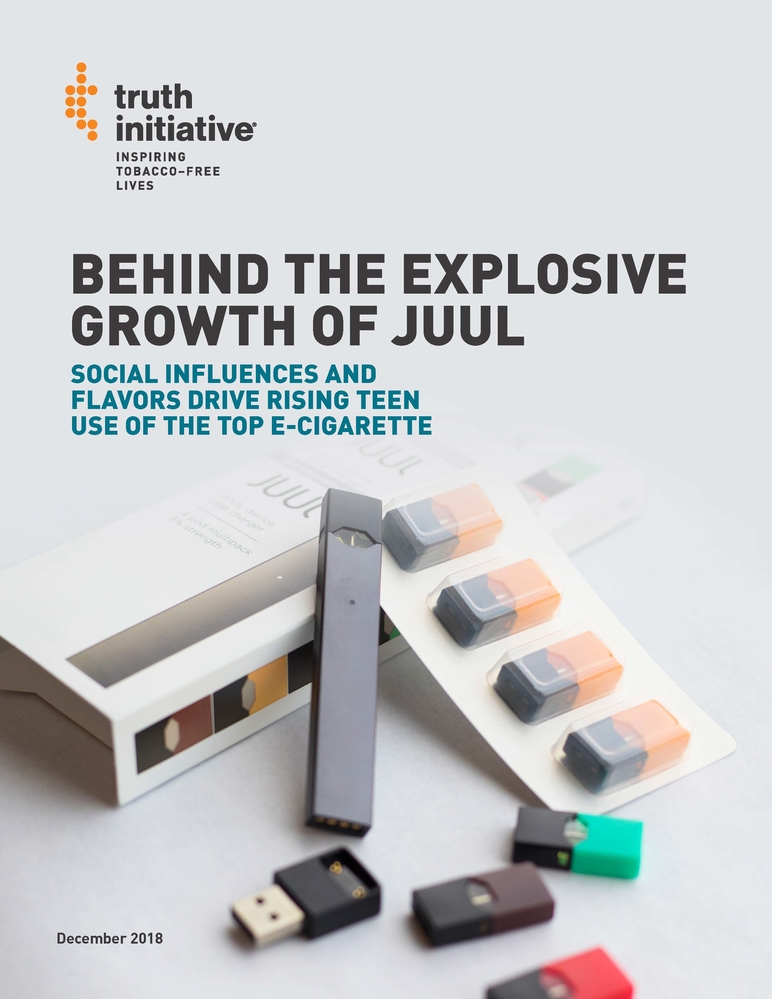
More in emerging tobacco products
Want support quitting? Join EX Program
By clicking JOIN, you agree to the Terms, Text Message Terms and Privacy Policy.
Msg&Data rates may apply; msgs are automated.
